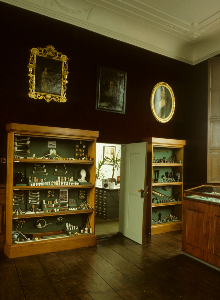French figural pipes > History

Like so many other museums, the Amsterdam Pipe Museum started as a private initiative. It was established forty years ago from an interest in archaeology. The growth of the collection always went hand in hand with research and archive studies. The history of the Dutch pipe industry was documented in various books and countless magazines by the founder and curator Don Duco. Archeologists routinely use his publications to identify pipes.
Over time, the museum collection has grown substantially, among other, with the addition of pipes from other European countries, the Middle-East, Africa and Asia. The Amsterdam Pipe Museum now owns a large collection of Mesoamerican Indian pipes, rare objects dating back to the time before Columbus discovered America. Smoking accessories such as tobacco boxes, pipe racks and cases placed the pipes in the context of their use in their day and age.
As a specialist museum the Amsterdam Pipe Museum also follows international developments. Following the closure of renowned tobacco collections, important objects were acquired for the museum in Amsterdam. This applies to both private and public collections, for example, the tobacco museums in Vienna, Paris and London. A special virtual exposition on the website of the Amsterdam Pipe Museum has been devoted to the growth of the collection.
In the 1980s and 1990s, the collection gained national publicity with the collection of Pijpenkabinet in Leiden. The museum, in the style room of a courtyard house, drew a large audience thanks to, for example, pipe making demonstrations. Pijpenkabinet was active not only within its own museum but it also made objects available for loan to other museums. The museum developed touring exhibitions which travelled to Belgium, Germany and Austria and in the Netherlands.
In 1995, Pijpenkabinet moved to the center of Amsterdam, where it occupies three floors of a pretty canal-side mansion, and includes a shop selling pipes and souvenirs. This new location draws an increasing number of international visitors. Visitors are invariably surprised by the variation, richness and artistic value of the pipes found in the permanent collection. In addition, a permanent auxiliary branch at the Openluchtmuseum (Open Air Museum) in Arnhem is an outpost of the Amsterdam Pipe Museum. In 2013 Pijpenkabinet changed its name to Amsterdam Pipe Museum.
<< Back
